| Title | Pages |
|---|---|
| Preface Dear readers of the Hacettepe Journal of Biology and Chemistry, Interest to our journal is increasing every year with the valuable contributions of scientists from our country and throughout the World. I am sure that we will continue to have excellent articles of diverse scientific areas from the scientists who were dedicated themselves to the research. Having worked on DNA repair mechanisms with about four decades Aziz Sancar won the Nobel Prize in Chemistry 2015. For scientists there is no other prize with the prestige of the Nobel Prize. In this age in which we are gradually losing interest to the basic sciences, the winning of Nobel Prize by a Turkish scientist, Aziz Sancar, in the Chemistry field become an invaluable moral and proud for us. 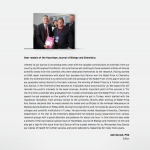
|
Preface |
| Botanic Origin, Various Physicochemical and Antioxidant Properties of Honey Samples From Giresun, Turkey The aim of the present study is to evaluate the botanic origin, various pysicochemical parameters (pH, mo- isture, hydroxymethylfurfural (HMF), fructose/glucose ratio) and antioxidant properties of the four honey samples colected from Giresun-Black Sea Region of Turkey. According to the mellisopalynological analyis, two of the investigated honey samples were determined as Castanea sativa honey and the other two samples were determined as multifloral honeys.The pH value of honey samples were found between 3.11 and 4.44. The moisture ot the investigted samples were varied between 11.59-14.13%. The fructose contents of the samples were found between 36.58 and 43.42 g/100 g and glucose values as 24.84-33.55 g/100 g. HMF values were 1.6±1.0 mg/kg for Castanea sativa honeys and 0.65±0.66 mg/kg for multifloral honeys. Total phenol contents were high for Castanea sativa honeys compare to two multifloral honeys but total flavonoid content is found as highest in sample 3 (multifloral honey). 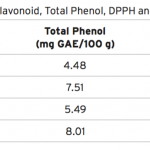
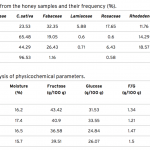
|
209 - 215 |
| In Vitro Inhibition of Human Plasma and Erythrocyte AChE by Various Drugs In the present study, the in vitro effects of eight structurally different antibiotics (cefazolin, kanamycin, gentamicin, clindamycin, ivermectin and ampicillin) and painkiller (metamizole and diclofenac) on human erythrocyte and plasma acetylcholinesterase activity (AChE; EC 3.1.1.7) were investigated. For this, IC50 and KI values of the drugs were calculated for determining the inhibition caused by these drugs. Acetylcholinesterase activity was determined spectrophotometrically, according to Ellman’s method. Then the enzyme activity exposed to the drugs with different concentrations was measured. AChE activity vs. drug concentration and Mihealis-Menten graphs were obtained. Lastly, IC50 and KI values were estimated from these graphs. IC50 values were estimated to be 1.78 x10-8 M of diclofenac for plasma AChE and 0.85x10-8 M of gentamicin for erythrocyte AChE. K values were 1.36 x10-8 M for diclofenac and 1.16 x10-8 M for gentamicin. Also, IC50 and KI values for ivermectin, clindamycin, kanamycin, ampicillin were obtained. Diclofenac exhibited the highest inhibitory effect on plasma AChE activity. On the other hand, gentamicin showed the highest inhibitory effect on erythrocyte AChE activity, which seems to be better for inhibition of AChE than those reported previously. 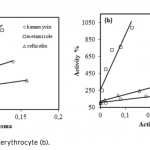
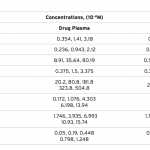
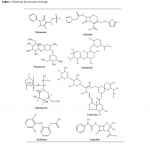
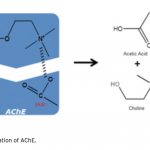
|
217 - 224 |
| Effect of Genotypes on Chemical and Physical Properties of Mulberry In this research, the physico-chemical properties and mineral composition of white (Morus alba L.), black (M. nigra L.) and urmu (M. nigra L.) mulberries, grown in Southeast Anatolia region of Turkey, were investigated. Urmu contained the highest total anthocyanin and phenolic compounds (1071 mg cyanidin-3-glucoside equiva- lents, and 1456 mg gallic acid equivalents/100 g fresh matter respectively), and white mulbery had the highest HMF and browning index (36.15 mg kg-1 and 17.61 respectively). Maximum L and b values were observed in white mulberry. The mean values of mineral compositions of the mulberry types in 100 g fresh fruith were 238 mg P, 1138 mg K, 139 mg Ca, 116 mg Mg, 6 mg Fe, 0.8 mg Cu, 4.3 mg Mn and 3.9 mg Zn. The highest total flavonoid and ascorbic acid were determined in urmu mulberry (312 mg quercetin equivalents/100 g fresh matter and 32 mg/100 g). 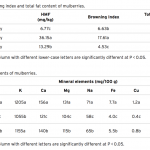
|
225 - 231 |
| Isolation, Identification and Enzyme Characterization of Lipase Producing Bacteria from Mucus Layer of Oncorhynchus mykiss In this study, 13 different bacteria were isolated from the surface mucus layer of Oncorhynchus mykiss (ra- inbow trout). These bacteria were identified as Exiguobacterium sp. (Om1), Acinetobacter sp. (Om2, Om7), Microbacterium sp. (Om3), Arthrobacter sp. (Om4), Sphingobacterium sp. (Om5), Stenotrophomonas sp. (Om6, 10 and 11), Pseudomanas sp. (Om8), Corynebacterium sp. (Om12) Aeromonas sp. (Om14) and Psychrobacter sp. (Om15) based on morphological, physiological, and biochemical characteristics, as well as phylogenetic analy- sis using 16S rDNA sequences. We report that isolate Om15 produces a cold-active lipase enzyme. The lipase enzyme was partially purified from the bacterial supernatant and its specific activity was calculated as 64.393 U g–1. Optimal performance of the enzyme occurred at pH 8.0 and 20°C using p-nitrophenyl dodecanoate as a substrate. SDS-PAGE indicated that the lipase enzyme is composed of 2 subunits 58-60 kDa, and that it is possible that the active lipase enzyme is the heterodimer of the subunits, which was confirmed via Native- PAGE. Furthermore, the lipase activity decreased in response to application of Co2+ and Cu2+ ions; however, no significant difference in the lipase activity was observed via application of other ions. 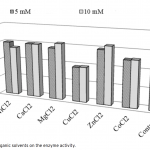

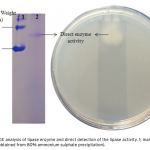
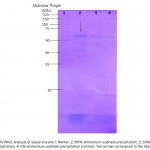
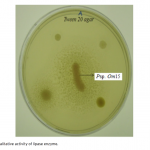
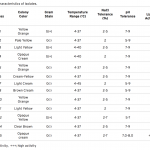
|
233 - 244 |
| Effect of Nisin and Gamma Irradiation Treatments on Listeria monocytogenes on Some High Economic Valued Aquaculture Products Fish and other aquaculture products play an important role in global consumption. Sea foods represented a higher risk of L. monocytogenes contamination compared with other foods. The risk of L.monocytogenes should be decreased using some novel protection methods. Various studies have shown that Nisin alone or combined with another technique is efficient for control of L.monocytogenes in different foods and different conditions. Additionally, gamma radiation has a significant potential for the extension of refrigerated shelf life and decontamination of pathogens in fishery products. We applied different doses of gamma irradiation on Pangasius (Pangasius hypophthalmus, Ln.) fillets, Herring caviars, Scallops and Pollock (Pollachius pollachius, Ln.) fish fillets weather treated with Nisin or not. The results showed that without Nisin application L. monocytogenes can be eradicated with 5 kGy of gamma irradiation, but when Nisin application is done the effective dose decreases to 3 kGy. It can be suggested that Nisin combined with gamma irradiation is effective on L.monocytogenes attached to different aquacultures. 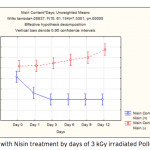
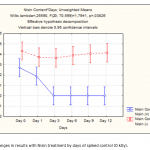
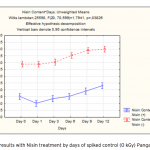
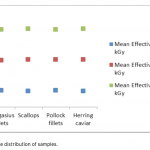
|
245 - 257 |
| DNA Purification by Solid Phase Extraction (SPE) Methods DNA isolation/purification is a widely used procedure for molecular biology, medical studies, gene therapy and especially PCR studies which needs high quality or extremely pure nucleic acid samples. Nucleic acid separation was mainly achieved by two methods; solvent extraction and solid phase extraction (SPE) methods. Although solvent extraction method is the simplest method, there are some drawbacks such as toxicity, more solvent requirement, time-consuming procedure and low specificity. Nowadays, there is a wide use of solid phase matrices to extract DNA from a variety of samples. In this review article; we basically focused on SPE for DNA purification methods. 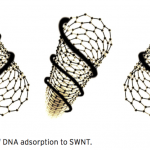
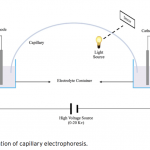

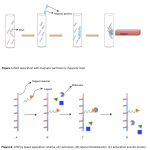
|
259 - 266 |
| Investigation of Antimicrobial Activity of Different Trametes versicolor Extracts on Some Clinical Isolates Intensive drug uses against species which have clinical significance and cause severe diseases have triggered the development of resistance in these species. It is necessary to discover new potential drugs against cli- nical isolates because many antimicrobial drugs become ineffective in the coming years. In this research, we used different extracts from Trametes versicolor fruiting bodies for investigating antibacterial and antifungal activities on some clinical isolates. For this purpose, five bacterial species (Staphylococcus aureus, Entero- coccus faecalis, Bacillus subtilis, Escherichia coli and Pseudomonas aeruginosa) and a fungal species (Candida albicans) were selected as clinically important isolates and four different crude extracts (chloroform, water, ethyl acetate and ethyl alcohol) of Trametes versicolor were tried on these species in terms of antimicrobial sensitivity with disc diffusion method. Obtained data were analyzed using SPSS 14 software. At the result, some of extracts were found to have antimicrobial activity on clinical isolates although all extracts generally show antimicrobial effect. Chloroform extract was found to have the highest antimicrobial activity on S. aureus and E. faecalis while ethanol extract was observed as more effective on P. aeruginosa, E. coli, B. subtilis and C. albicans isolates. It can therefore be suggested that, some of Trametes versicolor extracts are promising antimicrobial agents. 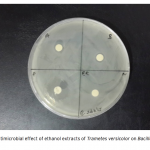
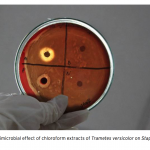

|
267 - 272 |
| Electrosoption of Aromatic Organic Acids From Aqueous Solutions Onto Granular Activated Carbon Electrodes for Water Purification Waste water treatment systems have great importance as a result of the increasing population and environ- mental pollution. In this study, electrosorptive removal of benzoic acid (BA) and nicotinic acid (NA) from aqueous solutions onto activated carbon electrodes (ACEs) were studied. ACEs were fabricated from the in- dustrially available granular activated carbon and polyethylene as binder. During the electrosorption process, the change in concentration of organic molecules was followed by using an online UV–Vis spectrophotometric system. Effects of operational parameters such as applied potential and volumetric flow rate on electrosorp- tion of BA were examined. Optimum parameters for the process were found to be 60 mL.min-1 for volumetric flow rate and 1.5 V for polarization of ACEs. Electrosorption of binary mixtures of BA and NA was also studied. it can be concluded that BA and NA can be effectively removed by electrosorption from aqueous solutions using activated carbon electrodes. 
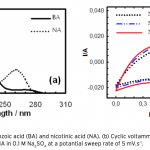
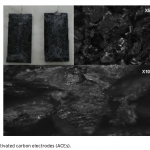
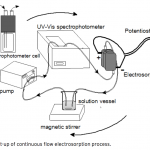
|
273 - 281 |
| Bone Marrow Mesenchymal Stem Cells to Improve Damaged Heart Function after Modified Myocardial Infarction Rat Model Although nowadays the treatment methods were improved, acute myocardial infarction (MI) and heart failu- re are the most important cardiovascular mortality and morbidity causes. In this study, mesenchymal stem cells (MSCs) collected from the bone marrow was injected into myocardial regeneration areas of the Wistar albino rats with modified ischemic heart model and this areas were investigated by using electrocardiographic (ECG) data and histopathological analysis. In stem cell implementation group, an increase in the amount of ves- sels and cells were observed. In this group, the amplitudes of P waves, QRS complex and T waves had no chan- ges, whereas there was a significant reduction on T wave duration and heart beat rate reduced significantly (p≤0,001). S-T depression increased to normal levels was observed in reference and control groups more than in stem cell implementation group. 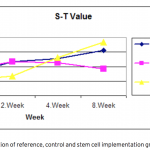


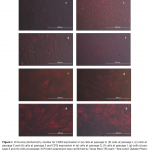
|
283 - 292 |
| Synthesis, Antioxidant, Xanthine Oxidase and Urease Inhibitory Activities of Some Chlorine Containing Benzimidazoles Aseries of tetra-substitued benzimidazole derivatives were synthesized and screened for their urease inhibi- tion, anti-xanthine oxidase (XO) and antioxidant activities. Some of them were found to possess significant antioxidant activity, especially, compounds 4, 5a, 5b, 5c, 5d and 6b exhibited highly scavenging activity in ABTS•+ radical cation decolorization assay (SC50: 9.51-70.43 μg/mL) and cupric reducing antioxidant capacity (CUPRAC) assay. Compound 6d exhibited the highest XO inhibition at 125 μg/mL. All compounds were evalua- ted with regard to Jack Bean urease activity and the most active compound concerning urease enzyme inhibi- tion was (5b), with an IC50 value of 7.41±0.13 μg/mL. 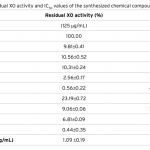
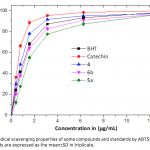

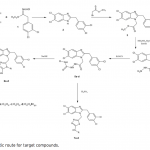
|
293 - 305 |
| New Chitosan-Glyoxal Beads Supported Pd(II) Catalyst: Synthesis, Characterization and Application in Suzuki Coupling Reactions In this paper, a new chitosan bead supported Pd(II) catalyst was prepared and its structure was characteri- zed with FTIR, XRD, TGA, SEM/EDAX and ICP-OES analyses for Suzuki coupling reactions. The catalytic and recyclable performances of the catalyst were explored in the synthesis of biaryl compounds under microwave heating and free solvent media. The catalyst provided good conversion reaction yields and high TON and TOF values with a simple and quick microwave heating procedure. In addition, the recycle tests indicated that the catalyst could be used for up to seven runs under optimum reaction conditions. 
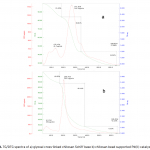
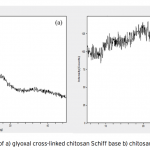
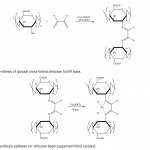
|
307 - 315 |
| The Effects of Silica and A Nature Polymer on the Size and Properties of Nano-Hydroxyapatite In this study, we compared the effects of silica and gelatin in nano hydroxyapatite (nHA) composite with pure hydroxyapatite. We have synthesized hydrothermal nHA gelatin template and silica. They (the obtained samples) were investigated by x-ray diffraction (XRD) and Fourier transform infrared spectroscopy (FT-IR). Scanning and transmission electron microscopy (SEM) was used for characterization of particle size and morp- hology of the samples. The percentage of elements in the prepared composite was determined using energy- dispersive x-ray spectroscopy (EDS). We have identified that the use of gelatin and silica as a coating agent for nHA contributes to the increase in the size of the particles. 

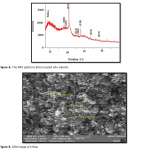

|
317 - 325 |
| The Chemical Analysis of Propolis, Which are Produced in Western of Turkey Propolis or bee glue is a natural product that contains numerous fairly strong chemical compounds and it is important for people health. But propolis collecting area and collecting time are very important for the product quality. For this purpose, this study conducted in the region of Muğla city in western of Turkey and propolis features uncovered. 27 propolis samples were collected from nine areas of the Muğla city in western of Turkey where honeydew beekeeping is practiced extensively, from September to November. GC-MS chemical substance analyses of 27 propolis samples revealed many chemicals including alcohols, aromatic alcohols, linear aldehydes, flavanones, linear hydrocarbons, linear acid esters, aromatic acids, aromatic esters, aromatic acid esters, aliphatic carboxilic acids, aliphatic carboxilic acid esters, aliphatic esters and other chemical substances. Propolis concentration changed between 0.71% and 13%. according to the amount of propolis used. 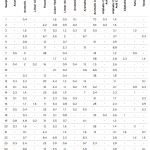
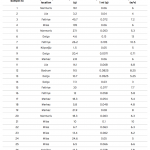
|
327 - 338 |
| Electroanalysis of Pyrocatechol in River Water Over Pt Electrode Modified with Polyaniline-Poly(3-methylthiophene)- Poly(3,3’-diaminobenzidine) Film Determination of pyrocatechol was successfully achieved over polyaniline - poly(3-methylthiophene) - poly(3,3’-diaminobenzidine) (PANI - P3MT - PDAB) coated Pt disc electrode using amperometric I-t method in NaHSO4/Na2SO4 (SBS) (pH 2.0) solution. The potential range of 0.45 V-0.65 V were implemented and a potential of 0.50 V was found to be an optimum potential. Analytical parameters (LOD, LOQ and linear range) were 7.37×10-5, 2.47×10-4 and 2.47×10-4-25.0 mmol.L-1, respectively. Furthermore, assay of pyrocatechol was performed in artificially contaminated river water samples over modified electrode at the pyrocatechol concentrations of 5.0 and 10.0 mmol.L-1 to check on the matrices interference and accuracy of the developed method. Recovery values were 101.1% and 101.2%, respectively. Without matrix effect, determination of pyro- catechol at lower peak potential (0.50 V) than oxidation peak potential (0.62 V) was carried out. 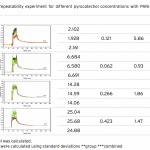
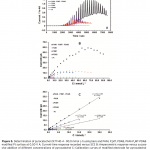
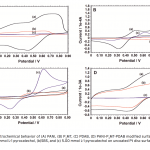
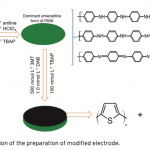
|
339 - 347 |
| Fabrication of TiO2 Nanoscale Thin Films and Its Structural Properties The photocatalytic properties of titanium dioxide with extraordinary stability have potential application in chemical industry. Titanium dioxide nanoparticles were synthesized by sol-gel method and used dip-coating method for the preparation of thin films on glass substrate. To study the structural and physical characteristics of the samples, the XRD, UV-VIS and an optical microscope were used. The results show that with increasing the annealing temperature and thickness, larger particle size obtained and energy gap is reduced. Thus, by controlling the annealing temperature and thickness can be achieved to the gap-controlled semiconductors. 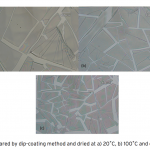
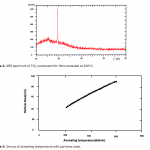

|
349 - 354 |
| Investigation of P53, HIPK-2 and EIF2S1 Genes Expression Changes Induced by in Vitro Gamma Radiation In this study, we have investigated induction of P53, HIPK-2 and EIF2S1 genes after exposure to low doses gam- ma radiation by using the peripheral human lymphocytes. Gene expression changes were analyzed in quanti- tative real time polymerase chain reaction (QRT PCR) by using B2M as a reference gene. Whole blood samples of ten young, healthy and non-smoking donors were taken. All samples were divided in to five specimens and four of them were irradiated using constant gamma irradiation source (60Co) giving the dose rate of 0.0327 kGy/h while one sample used as control. Blood samples were exposed to 0.1 Gy, 0.5 Gy, 1 Gy and 3 Gy γ-rays. Results were expressed in terms of the threshold cycle value (Ct) in REST 2009 (Relative Expression Software Tool V. 2.0.13) program and the difference between the CT values of the target gene and the reference gene was calculated. We found a linear dose–response relationship for P53, HIPK-2 and EIF2S1 genes. Results of the QRT PCR showed that three of the genes were up-regulated after radiation exposure. We concluded that P53, HIPK-2 and EIF2S1 genes can be promising for the assessment of gene expression changes in radiation expo- sure induced DNA damage. 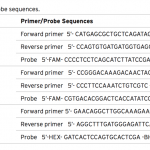

|
355 - 359 |
| Horseradish Peroxidase Immobilized into Organogel-Silica Composite for Transformation of Chlorophenols to Biodegradable Organic Acids Phenol and its derivatives are considered detrimental to environment and need to be removed from environ- ment. Enzymatic oxidation of chlorophenols is considered as viable option but leads to precipitate due to polymerization of phenolic compounds, which require additional step of flocculation towards safe discarding of contaminated waters. In present work, microemulsion organogel from cetyltrimethylammonium bromide reverse microemulsion and gelatin was prepared and used as immobilization matrix for horseradish peroxidase (HRP, E.C.1.11.1.7). The material was further hardened with silica to enhance aqueous solution stability. The composite material was studied for enzymatic kinetics and oxidation of chlorophenols and employed as catalyst in the presence of hydrogen peroxide to oxidize 2-chlorophenol (2-CP), 2,4-dichlorophenol (2,4 - DCP), and 2,4,6-trichlorophenol (2,4,6-TCP) in an aqueous media. It was worth noting that phenols get converted to organic acids rather than typical polymerized products. The protective effect of composite material was observed which render the polymerization reaction of phenols. Michaeles-Menten constant and activity of enzyme in free and immobilized system were evaluated using three modified Michaeles-Menten equations and progressive curve experiments, respectively. The immobilized HRP followed Michaeles-Menten kinetics with lower reaction velocity constant (Vmax) and Michealis constant (Km) values comparable to free HRP. Further, following parameters were optimized: contact time, pH, hydrogen peroxide concentration, enzyme dose and analyte concentration. Under different optimized condition, the oxidative removal of phenol and their derivatives reaches up to 95-99% in phosphate buffer. 
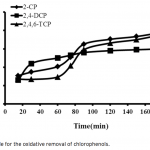
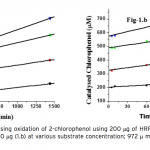

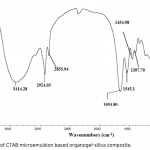
|
361 - 374 |